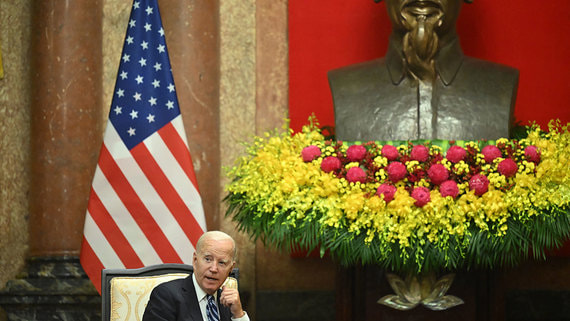The United States and Vietnam entered into a Strategic Comprehensive Partnership Agreement
[ad_1]

On September 11, Joe Biden, during a visit to Vietnam, announced a “new stage” in relations between Hanoi and Washington. On the 10-year anniversary of the “comprehensive partnership” between the two countries, which was also initiated by Biden while still vice president in the Obama administration, the parties signed an agreement to upgrade the level of partnership to a “comprehensive strategic partnership,” according to a joint statement published by the White House. “We are developing our partnership into a comprehensive, strategic, highest level. And we are delighted with this,” Biden said on September 11 at a press conference in the building of the Central Committee of the Communist Party of Vietnam (CPV) in Hanoi (quoted by the White House press service).
CPV Secretary General Nguyen Phu Trong explained that the increase in the status of partnership with the United States is happening “in the name of peace and sustainable development.” Vietnamese Prime Minister Pham Minh Trinh, who was present at the meeting, said in the context of cooperation with the United States that “the sky is the limit.” Vietnam also has declarations of “comprehensive strategic partnership” with China, Russia, South Korea and India.
The largest section in the announcement of the signing of the agreement is economic: it states the intention to weaken mutual trade barriers, the US decision to consider “as soon as possible” Vietnam’s September 8 request for recognition as a market economy country, to promote mutual investment, cooperation in scientific contacts, intellectual property protection. Washington and Hanoi also entered into agreements in the supply of semiconductors for American industry. The United States and Vietnam will increase diplomatic contacts and coordination in the Asia-Pacific region and “globally” to resolve international problems at all levels “in accordance with the Charter and resolutions of the UN Security Council.”
Touching upon security issues, Nguyen Phu Trong noted that in international conflicts, “Vietnam hopes that the parties concerned will peacefully resolve disputes based on respect for the principles of international law and the UN Charter.” Vietnam has territorial disputes with China in the South China Sea over the uninhabited Nansha Islands (Spratly Islands, also claimed by Taiwan, the Philippines, Malaysia and Brunei). On one of the islands of the archipelago, the PRC is building a naval base, having already deployed anti-ship systems and deployed air defense. According to the US Department of Energy, the Spratly shelf may contain up to 5.4 billion barrels of oil and up to 55.1 trillion cubic meters. m of natural gas.
Biden named a new level of partnership with Vietnam among such priority agreements for Washington as the August agreements with Japan and South Korea, the alliance with the Philippines, AUKUS with Australia and the UK, QUAD with India, Australia and Japan, as well as the Indo-Pacific Economic prosperity”, to which the United States will now also include the Vietnamese. In 2022, Washington was Hanoi’s second largest trade and economic partner. China remains first. In 2022 alone, Nguyen Phu Trong visited Beijing twice – in March and October. He was the first foreign leader to visit Chinese President Xi Jinping after Xi was re-elected for a third term, concluding a number of economic agreements.
The United States is interested in pulling Vietnam away from China and creating a barrier for Beijing in the region, given that Hanoi is the only one that can create “real problems” for Beijing in Southeast Asia and has territorial disputes with it, says the head of the Center for the Study of Southeast Asia. East Asia, Australia and Oceania IV RAS Dmitry Mosyakov. But the new level of partnership should not deceive Washington: Beijing, India and Russia already have relations in this format with Hanoi, and it is unlikely that the US will be able to interrupt Chinese trade volumes in the near future, Mosyakov believes. “It will be difficult for the United States to switch Vietnam economically: the country is not at the beginning, but in the middle of many production chains between Washington and Beijing,” explains the expert.
Hanoi fundamentally prefers to carefully use the benefits of multi-vector development without getting too close to anyone, notes Mikhail Terskikh, a researcher at the Center for the Indian Ocean Region of the IMEMO RAS. “It’s hardly worth expecting real fundamental changes in relations yet. But the upward trend in US-Vietnamese relations is a fact; Hanoi is trying to balance contacts with its northern neighbor,” says Terskikh.
The change in the status of US-Vietnamese relations at this stage should not be overestimated, says Fedor Voitolovsky, head of the US domestic and foreign policy sector at IMEMO RAS. According to the expert, the United States wants to get as close as possible to Vietnam, but realizes that Hanoi will not sacrifice relations with China. The expert admitted that the Americans act systematically and their initiatives have a serious economic basis. “Vietnam needs the United States from the point of view of technology and investment; American manufacturers, in turn, are very interested in Vietnam as a source of labor,” concluded Voitolovsky.
Vietnam is firmly not going to become in relation to China what Ukraine became in relation to Russia for the United States, says a Vedomosti source close to the Russian Ministry of Defense.
[ad_2]
Source link








